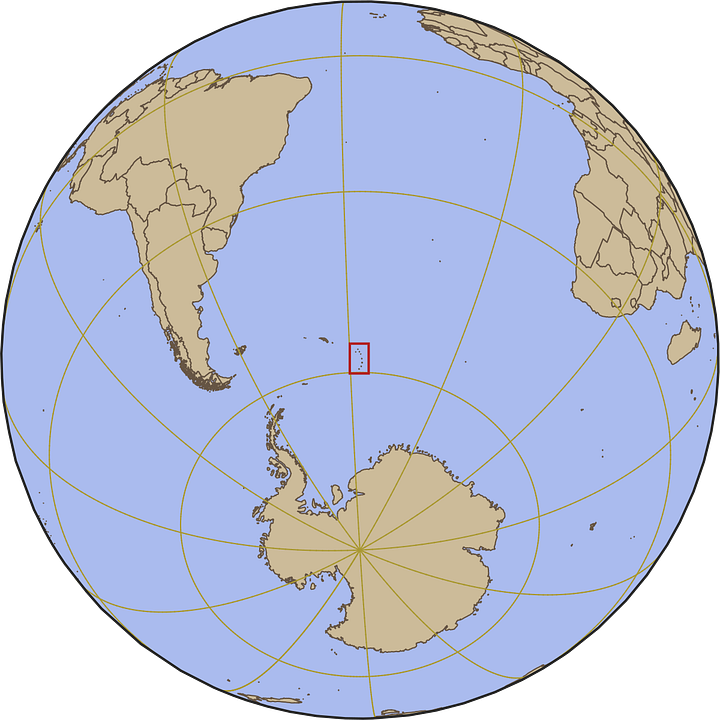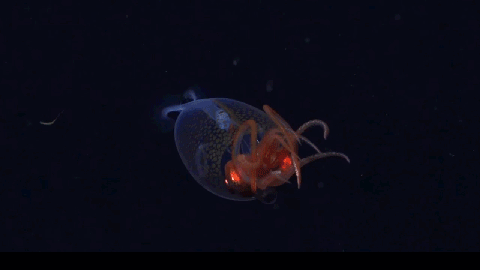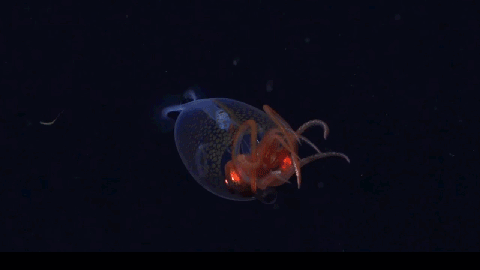Not-Quite-Colossal Squid
First-ever sighting of a live Mesonychoteuthis hamiltoni, but it's just a kid
The fascinating creature in today’s gif was filmed by an international team of scientists during a research expedition in the South Sandwich Islands in the South Atlantic in early March. Crew aboard the Schmidt Ocean Institute research vessel Falkor (too) were piloting their remotely operated vessel (ROV) SuBastian at a depth of about 600 meters (roughly 2000 feet) when they spotted a juvenile colossal squid, thought to be the first-ever confirmed1 live, swimming observation of this elusive animal.


Little is known about this species of squid (Mesonychoteuthis hamiltoni), a resident of the deep circumantartic Southern Ocean. In the 100 years since its discovery in 1925, only eight adult specimens have been collected, taken from the digestive tracts of whales and other depth feeders, or a handful caught dead or nearly-dead by commercial fishing operations. The Te Papa Museum in New Zealand has the only complete, publicly-displayed colossal squid in the world. I’ve seen it and it’s pretty big! Their display squid is 4.2 meters, that’s almost 14 feet in length.

Although the squid captured on camera was only about 30cm long, she’s destined to get much bigger. While morphology of the colossal squid is based on incomplete knowledge limited by scarcity of observable subjects, it is estimated that colossal squid typically grow to seven meters (23 ft) in length, although modeling based on the beaks found in whale stomachs indicate that they may get up to 10 meters long (33 ft). Fully grown colossal squid weigh about 500 kilograms (1100 lbs), already making them the heaviest invertebrate on Earth, but modeling based on beak samples bring that estimate up to between 600-700 kilograms (1300 to 1500 lbs) for larger specimens.

The depth at which the colossal squid lives changes as it ages. Young squid are found at a depth of between 0–500 m (0–1,640 ft), while adolescent squid like the one filmed are found 500–2,000 m (1,600–6,600 ft). Adult squid are found primarily within the mesopelagic and bathypelagic regions of the open ocean. A member of the glass squid family (the squid squad!), they lose their glass-like transparency sometime before reaching full adulthood. I’m assuming because it’s really, really dark down there at the depths and nobody can see you anyway (that’s a joke—but who knows, maybe I’m a secret marine biologist; although I’m not, as far as you know).

Colossal squid also have the largest eyes of any current animal on the planet, perhaps of any creature that has ever lived on Earth, at a diameter of 27-30 cm (11-12 in) and with the largest collected specimen having an eye diameter of 40 cm (16 in). Each eye is equipped with a photophore behind its pupil, acting as a built-in headlight which allows it to see further in the inky blackness of the deep sea. Researchers speculate that those big eyes might be one of the reasons that filming a colossal squid has proven especially challenging; they can see ROVs far before cameras can get close enough to film and will swim off to avoid a potential predator. Technology such as low-light or red-light systems can aid in underwater recording, as they are less likely to disturb deep sea animals and they will likely be used on future searches for this enigmatic creature of the unexplored depths.
The source for today’s video is taken from Schmidt’s YouTube channel and is linked below. I’ve also included a few links so you can check out more about this intriguing animal; if you were a sperm whale, you’d be all over that, with butter or a nice garlic aioli—scientists estimate that colossal squid make up about 75% (by weight) of this deep-feeding whale’s diet.
Schmidt Ocean Institute: “First Confirmed Footage of a Colossal Squid—and it’s a Baby!” 4/15/25
Wikipedia: Bathypelagic zone & Mesopelagic zone
Wikipedia: South Sandwich Islands
Plastic texture image by lawanastudio at Freepik
In 2023, the exploration and conservation nonprofit Kolossal captured footage of another Antarctic giant glass squid, but the video resolution was too low to confirm definitively if their images were that of the colossal squid.





Wow!! Even more fascinating than usual, Martini. You win this morning's round of Reasons to Get Up.
Talk nerdy to me all day please 😅